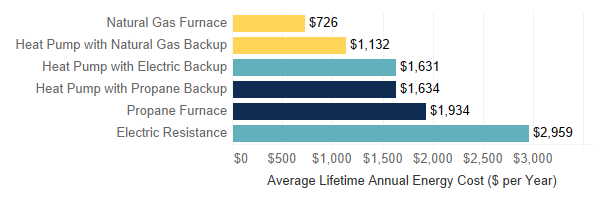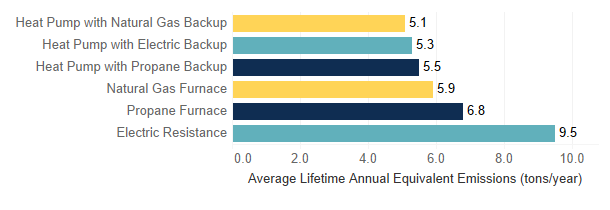CEE developed a calculator to demonstrate how energy costs and electric grid composition affect residential heating system performance in Minnesota’s climate. A user can compare the cost and carbon emissions of different technologies under various future scenarios. The following summary offers background information on the factors that go into the calculator and explores some of the key results.
What is equitable electrification?
Electrification refers to a transition from carbon-intensive services that our economy relies on (for transportation, heating, industry, and more) to decarbonized electric technologies. Equitable electrification* ensures this transition happens in planned, managed steps that allow the benefits and costs to be equitably distributed across society — yielding savings in costs, energy, and emissions and avoiding the creation of new grid infrastructure.
The sources from which we generated electricity have shifted dramatically in Minnesota over the past 20 years. Wind and solar now make up 20% of Minnesota's electric generation. Coal generation has declined, and upcoming retirements of numerous large coal plants have been announced. Consequently, electricity on Minnesota's grid is much cleaner than it has been in the past.
What is a cold-climate air source heat pump?
Air source heat pumps transfer heat between the outside air and the inside of a building, similar to how a refrigerator operates. Air source heat pumps can use that heat transfer ability both to cool buildings in the summer and to heat buildings in the winter. They use considerably less energy than other equipment used to heat or cool spaces, making them an efficient option for space conditioning. In the past, air source heat pumps have struggled to perform in cold temperatures, but recent technology advancements have improved their ability to transfer heat even in Minnesota’s winters — however, homes should still have a backup system for especially cold days.
Air Source Heat Pump Costs and Carbon Savings
Below are the calculator’s preliminary results for the lifetime costs and emissions of air source heat pumps compared to other heating options. We encourage you to run different scenarios to explore various cost and emissions outputs.
CEE’s calculator is free to use and open to all. This short video explains how to use the tool and may be helpful to watch before getting started. There is a survey within the tool to allow user feedback.
Operating Costs
Below are average lifetime energy costs for various systems with assumed fuel costs of $0.70 per therm of natural gas, $0.13 per kWh for electricity, and $1.6 per gallon for propane. A natural gas furnace has the lowest lifetime operating cost to heat a home. However, for homes with electric resistance or propane as the primary heating source, a cold-climate air source heat pump with electric or propane backup is the more cost-effective solution.

Average lifetime annual energy operating costs per year.
Carbon Emissions
The following results assume that coal power plant retirements occur as stated in approved Minnesota utility integrated resource plans, and that non-scheduled coal plant retirements occur when they have fully economically depreciated. Other assumptions include that nuclear plants continue to operate and that renewable additions occur as stated in the most recent utility integrated resource plans (from 2017). Any energy deficits are met with two-thirds renewable resources and one-third natural gas resources.
Under these assumptions, a cold-climate air source heat pump with natural gas backup yields the lowest lifetime emissions, slightly better than a heat pump with electric resistance backup. The technologies with the highest lifetime emissions are propane furnaces and electric resistance heating systems.

Average lifetime annual equivalent emissions.

Carbon emission percent generation per year.
Replacing electric resistance heating systems and propane furnaces with cold-climate air source heat pumps (with electric or propane backup systems) is a better option from the perspectives of both emissions and operating costs.
Heating homes with natural gas is still the most widespread and cheapest option in terms of lifetime operating costs. However, if natural gas prices change in the future relative to electricity, this conclusion would change as well. Additionally, the lower costs are balanced with higher emissions relative to other system options.
To learn more about air source heat pumps and the related concepts discussed in this blog, check out CEE’s ACEEE publication on this topic.
* Since the time of posting, CEE composed a roadmap toward equitable decarbonization, "the just and equitable transition from the carbon-intensive energy services ... to decarbonized technologies and fuels in planned, managed steps, so that the benefits and costs of that transition are equitably distributed across society." The word change simply underscores our strategic focus on electrification's main goal: decarbonization. Read the rest of our 2040 vision here.
